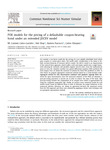Mostrar o rexistro simple do ítem
PDE Models for the Pricing of a Defaultable Coupon-Bearing Bond Under an Extended JDCEV Model
| dc.contributor.author | Calvo-Garrido, María-del-Carmen | |
| dc.contributor.author | Diop, Sidi | |
| dc.contributor.author | Pascucci, Andrea | |
| dc.contributor.author | Vázquez, Carlos | |
| dc.date.accessioned | 2021-08-24T11:17:51Z | |
| dc.date.available | 2021-08-24T11:17:51Z | |
| dc.date.issued | 2021 | |
| dc.identifier.citation | CALVO-GARRIDO, M. Carmen, et al. PDE models for the pricing of a defaultable coupon-bearing bond under an extended JDCEV model. Communications in Nonlinear Science and Numerical Simulation, 2021, p. 105914. | es_ES |
| dc.identifier.uri | http://hdl.handle.net/2183/28311 | |
| dc.description | Financiado para publicación en acceso aberto: Universidade da Coruña/CISUG | |
| dc.description.abstract | [Abstract] We consider a two-factor model for the pricing of a non callable defaultable bond which pays coupons at certain given dates. The model under consideration is the Jump to Default Constant Elasticity of Variance (JDCEV) model. The JDCEV model is an improvement of the reduced form approach, which unifies credit and equity models into a single framework allowing for stochastic and possible negative interest rates. From the mathematical point of view, the valuation involves two partial differential equation (PDE) problems for each coupon. First, we obtain the existence of solution for these PDE problems. In order to solve them, we propose appropriate numerical schemes based on a Crank-Nicolson semi-Lagrangian method for time discretization combined with quadratic Lagrange finite elements for space discretization. Once the numerical solutions of the PDEs are obtained, a post-processing procedure is carried out in order to achieve the value of the bond. This post-processing includes the computation of an integral term which is approximated by using the composite trapezoidal rule. Finally, we present some numerical results for real market bonds issued by different firms in order to illustrate the proper behaviour of the numerical schemes. Moreover, we obtain an agreement between the numerical results from the PDE approach and those ones obtained by applying a Monte Carlo technique and an asymptotic aproximation method. | es_ES |
| dc.description.sponsorship | Xunta de Galicia; ED431C2018/033 | es_ES |
| dc.description.sponsorship | Second, third and fourth authors have been supported by EU H2020-MSCA-ITN-2014 (WAKEUPCALL Grant Agreement 643045). First and fourth authors have partially been funded by Spanish MINECO with the grant PID2019-10858RB-I00 and by Galician Government with the grant ED431C2018/033, both including FEDER financial support. First and fourth authors also acknowledge the support received from the Centro de Investigacin de Galicia “CITIC”, funded by Xunta de Galicia and the European Union (European Regional Development Fund- Galicia 2014–2020 Program), by grant ED431G 2019/01. Funding for open access charge: Universidade da Coruña/CISUG. | |
| dc.language.iso | eng | es_ES |
| dc.publisher | Elsevier | es_ES |
| dc.relation | info:eu-repo/grantAgreement/EC/H2020/643045 | es_ES |
| dc.relation | info:eu-repo/grantAgreement/AEI/Plan Estatal de Investigación Científica y Técnica y de Innovación 2017-2020/PID2019-108584RB-I00/ES/METODOS MATEMATICOS Y COMPUTACIONALES PARA NUEVOS RETOS EN FINANZAS CUANTITATIVAS, MEDIAMBIENTE, BIOTECNOLOGIA E INGENIERIA | |
| dc.relation.uri | https://doi.org/10.1016/j.cnsns.2021.105914 | es_ES |
| dc.rights | Atribución-NoComercial-SinDerivadas 4.0 Internacional | es_ES |
| dc.rights.uri | http://creativecommons.org/licenses/by-nc-nd/4.0/ | * |
| dc.subject | Defaultable coupon bond | es_ES |
| dc.subject | JDCEV pricing model | es_ES |
| dc.subject | PDE formulation | es_ES |
| dc.subject | Semi-Lagrangian method | es_ES |
| dc.subject | Quadratic Lagrange finite elements | es_ES |
| dc.title | PDE Models for the Pricing of a Defaultable Coupon-Bearing Bond Under an Extended JDCEV Model | es_ES |
| dc.type | info:eu-repo/semantics/article | es_ES |
| dc.rights.access | info:eu-repo/semantics/openAccess | es_ES |
| UDC.journalTitle | Communications in nonlinear science and numerical simulation | es_ES |
| UDC.volume | 102 | es_ES |
| UDC.startPage | 105914 | es_ES |
| dc.identifier.doi | 10.1016/j.cnsns.2021.105914 |
Ficheiros no ítem
Este ítem aparece na(s) seguinte(s) colección(s)
-
GI-M2NICA - Artigos [57]
-
OpenAIRE [288]






